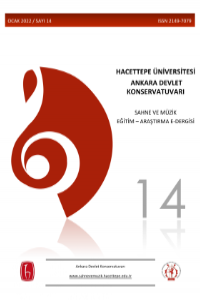SOFAR SOUNDS TÜRKİYE: ALTERNATİF TINI’DAN ANA AKIM’A
2009 yılında Londra’da ortaya çıkan Sofar Sounds, 2013 yılında Sofar Sounds İstanbul ismiyle Türkiye’ye gelmiştir. Açılımı Songs From A Room (Bir Odadan Şarkılar) olan Sofar Sounds konserleri bir evde düzenlenir ve amaç, dinleyicilerin sessizlik içerisinde canlı müzik dinlemesidir. Konserin mekânı ve performans sergileyecek müzisyenler konser ânına kadar gizli tutulmaktadır. Gizli ev konserlerinde ticari kaygıların sonucu olarak Sofar Sounds’un “markalaşmasının” yanı sıra katılımcıların etkinliğe ve markaya dâhil olması ile birlikte bir ortaklık yaratılması söz konusudur. Sofar Sounds Türkiye konserlerinde müzisyenlere ücret ödenmemektedir; bunun yerine konser kayıtları İnternet ortamına yüklenmektedir. Dolayısıyla bu durum, oluşumun popülerleşmesini ve görünürlüğünü arttırmaktadır. Bu bağlamda popülerleşen yapının ana akım ve alternatif müzik ile paralellikleri ve karşıtlıkları görülebilmektedir. Bu çalışmada, Sofar Sounds Türkiye’nin kuruluşu, amaçları ve “markalaşma” süreci; oluşumun ana akım ve alternatif müzik sahneleriyle olan ilişkisi; müzisyenlerin parçalarının benzerlikleri, yapılan armoni ve form analizleri ile birlikte incelenecektir.
Anahtar Kelimeler:
Sofar Sounds, alternatif/bağımsız müzik, ana akım, kendin yap (DIY), müzik endüstrisi.
SOFAR SOUNDS TURKIYE: FROM ALTERNATİVE SOUND TO MAINSTREAM
Sofar Sounds, which emerged in London in 2009, have begun to be organized in Turkey under the name Sofar Sounds Istanbul in 2013. Sofar Sounds concerts, which stands for Songs From A Room, are held in a house and the main purpose for the audience is to experience live music in silence. The venue of the concert and the musicians who will perform are kept secret until the moment of the concert. In secret house concerts, as a result of commercial concerns, as well as the "branding" of Sofar Sounds, a partnership is created with the involvement of the participants in the event and the brand. Musicians are not paid at Sofar Sounds Turkey concerts; instead, concert recordings are uploaded to the Internet. Therefore, this situation increases the popularization and visibility of the formation. In this context, the parallels and contrasts of the popularized structure with mainstream and alternative music can be seen. In this study, the establishment, aims and "branding" process of Sofar Sounds Turkey; the relationship of the formation with the mainstream and alternative music scenes; The similarities of the pieces of the musicians will be examined together with the harmony and form analysis.
___
- Attali, Jacques. 2002. Noise: The Political Economy of Music. Minneapolis: University of Minnesota Press.
- Baker, S., Bennett, A. ve Taylor, J. (ed.). (2013). Redefining Mainstream Popular Music. New York: Routledge.
- Baş, T. (2020). Türk Alternatif Müziğinin Yeni Performans Mekanları Bağlamında Streaming Müzik Platformları. Yüksek Lisans Tezi, Bursa Uludağ Üniversitesi.
- Bennett, A., Rogers, I. (2016). Popular Music Scenes and Cultural Memory. Londra: Macmillan Publishing.
- Bennett, A. (2018). Youth, Music and DIY Careers. Cultural Sociology, 12(2), 133-139.
- Bourdieu, P. (2016). Sosyoloji Meseleleri, (L. Ünsaldı, B. Çetin, A. Sümer, M. Gültekin, F. Öztürk, B. Uçar, çev). Ankara: Heretik. (1980).
- Dellaloğlu, B. (2007). Frankfurt Okulu'nda Sanat ve Toplum, Ankara: Say.
- Feld, Steven. (2000). A Sweet Lullaby for World Music. Public Culture 12(1), 145-171.
- Frith, S. (1987). Towards an Aesthetic of Popular Music. Taking Popular Music Seriously (258-272), Londra: Routledge.
- Moore, A. F. (2001). Indie Music. S. Sadie (Ed.). The New Grove Dictionary of Music and Musicians (c.12, s. 273-274). ABD: Oxford University Press.
- Pelly, L. (2019). Sofar, So Bad: A Global Startup Aims To Expolit The Underground Music Scene. The Baffler, 48, 96-107.
- Peterson, R., Bennett, A. (2004). Introducing Music Scenes. A. Bennett, R. Peterson (Ed.). Music Scenes: Local, Translocal and Virtual (s. 1-15). Nashville: Vanderbilt University Press.
- Riom, L. (2020). Discovering Music at Sofar Sounds: Surprise, Attachment, and the Fan–Artist Relationship. T. Tofalvy, E. Barna (Ed.). Popular Music, Technology, and the Changing Media Ecosystem. (s. 201-217). Palgrave: Cham.
- Robinson, J. B. (2001). Scat Singing. S. Sadie (Ed.). The New Grove Dictionary of Music and Musicians (c.22, s. 419-420). ABD: Oxford University Press.
- Başlangıç: 2015
- Yayıncı: Hacettepe Üniversitesi
Sayıdaki Diğer Makaleler
SOFAR SOUNDS TÜRKİYE: ALTERNATİF TINI’DAN ANA AKIM’A
MUAMMER SUN’UN “YURT RENKLERİ 3” ADLI PİYANO YAPITININ BİÇİMSEL ÇÖZÜMLEMESİ
RICHARD STRAUSS’UN Mİ BEMOL MAJÖR İKİ NUMARALI (TrV 283) KORNO KONÇERTOSU’NUN MÜZİKAL ANALİZİ
ROLAND BARTHES’IN ‘STUDIUM’ VE ‘PUNCTUM’ KAVRAMLARININ OYUNCUNUN KARAKTER İNŞASINDAKİ KARŞILIĞI
DEVLET TİYATROLARI GELENEĞİNİN İÇİNDE FARKLI BİR BİÇİM DENEMESİ: ANNA KARENİNA
Yeşim BALTACIOĞLU, Erdal Ozan METİN
